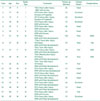Abstract
Purpose
This study was designed in order to evaluate the clinical results and frequency of complications of patients who underwent surgical treatment for traumatic dislocation of the hip with a femoral head fracture.
Materials and Methods
Eighteen cases of Thompson-Epstein type V femoral head fracture with dislocation of the hip from November 2002 to November 2011 were analyzed retrospectively. We divided the cases into two groups according to availability of closed reduction and reduction time, and analyzed the clinical results according to Epstein criteria and frequency of avascular necrosis of the femoral head and posttraumatic osteoarthritis.
Results
Among all patients, the observed complications included three cases of avascular necrosis and one case of posttraumatic osteoarthritis. The data showed that 14 cases were available for closed reduction; otherwise, there were four cases of failure. Significant differences were observed in clinical results and frequency of complications. Results regarding reduction time showed that 10 cases took 6 hours, and the other eight cases took more than 6 hours. There were no differences in clinical results, but, better results were achieved with a reduction time in 6 hours. However, significant differences were observed in frequency of complications.
Figures and Tables
 | Fig. 1(A, B) A 23-year-old male sustained Pipkin type I fracture of hip. (C, D) Open reduction and internal fixation of femoral head with trochanter flip osteotomy was done. The radiograph and CT at postoperative 20 months shows complete healing of the fracture, and there is no evidence of avascular necrosis of femoral head or post-traumatic osteoarthritis. |
 | Fig. 2(A, B) A 71-year-old male sustained Pipkin type IV fracture of hip. (C) Open reduction and internal fixation of acetabulum with spring plate and screws through the Kocher-Langenbeck approach was done. (D, E) The radiograph and CT at postoperative 2 months shows neglected posterior dislocation of hip. (F, G) Bipolar hemiarthroplasty of hip was done. The radiograph at postoperative 30 months shows well maintained prosthesis. |
 | Fig. 3(A, B) A 42-year-old male sustained Pipkin type IV fracture of hip. (C) Open reduction and internal fixation with reconstruction plate and screws through the Kocher-Langenbeck approach with trochanter flip osteotomy. (D) The radiograph at postoperative 21 months shows avascular necrosis of femoral head and osteoarthritis change on the joint. (E, F) Total hip arthroplasty was done. The radiograph at postoperative 96 months shows stable fixation of cup and stem. |
Table 2
Comparison of Clinical Results and the Complications between Group R and Group NR According to the Availability of Reduction

Table 3
Comparison of Clinical Results and the Complications between Group S and Group L According to the Reduction Time

Group S: Reduction time took in 6 hours, Group L: Reduction time took over 6 hours.
The values are given as the number of hips, with the percentage in parentheses.
*Significant at P<0.05.
†P-value using Fisher's exact test.
‡AVN: Avascular Necrosis of Femoral Head, §OA: Post-traumatic Osteoarthritis.
References
1. Brumback RJ, Kenzora JE, Levitt LE, Burgess AR, Poka A. Fractures of the femoral head. Hip. 1987. 181–206.
2. Butler JE. Pipkin Type-II fractures of the femoral head. J Bone Joint Surg Am. 1981. 63:1292–1296.

4. Thompson VP, Epstein HC. Traumatic dislocation of the hip; a survey of two hundred and four cases covering a period of twenty-one years. J Bone Joint Surg Am. 1951. 33-A:746–778. passim.
5. Pipkin G. Treatment of grade IV fracture-dislocation of the hip. J Bone Joint Surg Am. 1957. 39-A:1027–1042. passim.

6. Canale ST, Campbell WC. Campbell's operative orthopaedics. 1998. 9th ed. St. Louis: Mosby;2224–2234.
7. Rockwood CA, Green DP, Heckman JD, Bucholz RW. Rockwood and Green's fractures in adults. 2001. 5th ed. Philadelphia: Lippincott Williams & Wilkins;1559–1560.
8. Stimson LA. Five cases of dislocation of the hip. NY Med J. 1889. 50:118–121.
9. Epstein HC. Posterior fracture-dislocations of the hip; long-term follow-up. J Bone Joint Surg Am. 1974. 56:1103–1127.
10. Lyddon DW Jr, Hartman JT. Traumatic dislocation of the hip with ipsilateral femoral fractures. A case report. J Bone Joint Surg Am. 1971. 53:1012–1016.
11. Gittins ME, Serif LW. Bilateral traumatic anterior/posterior dislocations of the hip joints: case report. J Trauma. 1991. 31:1689–1692.

12. Stannard JP, Harris HW, Volgas DA, Alonso JE. Functional outcome of patients with femoral head fractures associated with hip dislocations. Clin Orthop Relat Res. 2000. (377):44–56.

13. Marchetti ME, Steinberg GG, Coumas JM. Intermediate-term experience of Pipkin fracture-dislocations of the hip. J Orthop Trauma. 1996. 10:455–461.

14. Watson-Jones R, Wilson JN. Watson-Jones Fractures and joint injuries. 1982. 6th ed. New York: Churchill Livingstone;885–934.
15. Epstein HC, Wiss DA, Cozen L. Posterior fracture dislocation of the hip with fractures of the femoral head. Clin Orthop Relat Res. 1985. (201):9–17.

16. Pape HC, Rice J, Wolfram K, Gansslen A, Pohlemann T, Krettek C. Hip dislocation in patients with multiple injuries. A follow up investigation. Clin Orthop Relat Res. 2000. (377):99–105.
17. Kim JH, Lee SH, Moon YL, Kim DH, Song KS. Treatment of femoral head fracture with traumatic posterior dislocation of the hip. J Korean Hip Soc. 2007. 19:176–182.

18. Park MS, Rho CK. Clinical analysis of femoral head fracture. J Korean Orthop Assoc. 1992. 27:502–510.





 PDF
PDF ePub
ePub Citation
Citation Print
Print




 XML Download
XML Download